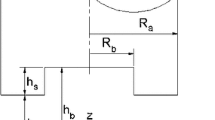Abstract
In order to study the squeeze-strengthening effect of silicone oil-based magnetorheological fluid (MRF), theoretical basis of disc squeezing brake was presented and a squeezing braking characteristics test-bed for MRF was designed. Moreover, relevant experiments were carried out and the relationship between squeezing pressure and braking torque was proposed. Experiments results showed that the yield stress of MRF improved linearly with the increasing of external squeezing pressure and the braking torque increased three times when external squeezing pressure achieved 2 MPa.
Similar content being viewed by others
References
Liu X H, Liu H, Liu Y Z. Simulation of Magnetorheological Fluids Based on Lattice Boltzmann Method with Double Meshes[J]. Journal of Applied Mathematics, 2012: 1–16
Liu X H, Liu Y Z, Liu H. Dynamic Simulation for Three-Dimensional Micro-Structure of Magnetorheological Fluids[J]. AISS: Advances in Information Sciences and Service Sciences, 2012, 12(4): 55–61
Sung H H, Seong M S, Choi S B. Design and Vibration Control of Military Vehicle Suspension System Using Magnetorheological Damper and Disc Spring[J]. Smart Materials and Structures, 2013, 22(6): 1–10
Jha S, Jain V K. Rheological Characterization of Magnetorheological Polishing Fluid for MRAFF[J]. International Journal of Advanced Manufacturing Technology, 2009, 42: 656–668
Ma J Z, He J M, Huang J. Analysis on Transmission Properties of a Cylindrical Magnetorheological Clutch[J]. Journal of Chongqing Institute of Technology (Natural Science), 2009, 3: 34–38
Olabi A G, Grunwald A. Design and Application of Magnetorheological Fluid[J]. Materials and Design, 2007, 28: 2658–2664
Sheng R, Flores G A, Liu J. In Vitro Investigation of a Novel Cancer Therapeutic Method Using Embolizing Properties of Magnetorheological[J]. Journal of Magnetism and Magnetic Materials, 1999, 194: 167–175
Nguyen Q H, Choi S B. Optimal Design of a Novel Hybrid MR Brake for Motorcycles Considering Axial and Radial Magnetic Flux[J]. Smart Materials and Structures, 2012, 21(5): 055003
Sidpara A, Jain V K. Theoretical Analysis of Forces in Magnetorheological Fluid Based Finishing Process[J]. International Journal of Mechanical Sciences, 2012, 56(1): 50–59
Andrzej M, Mikolaj H. Application of Magnetorheological Fluid in Industrial Shock Absorbers[J]. Mechanical Systems and Signal Processing, 2012, 28: 528–541
Zheng X P, Guo Y F, Chen S M. A Summary of Research on Magnetorheological Fluid and Its Application[J]. Construction Machinery and Equipment, 2011, 42(12): 49–52
Wang H, Yang Z, Han S J. Magneto-rheological Fluid Technology and Its Application[J]. Mechanical Engineering & Automation, 2010, 4: 207–211
Liu X H, Lu H, Chen Q Q, et al. Study on the Preparation and Properties of Silicone Oil-Based Magnetorheological Fluids[J]. Materials and Manufacturing Processes, 2013, 28: 631–636
Rong Y, Tao R, Tang X. Flexible Fixturing with Phase-Change Materials. Part1. Experimental Study on Magnetorheological Fluids[J]. International Journal of Advanced Manufacturing Technology, 2000, 16(11): 822–829
Zhang X Z, Gong X L, Zhang P Q, et al. Study on the Mechanism of the Squeeze-Strengthen Effect in Magnetorheological Fluids[J]. Journal of Applied Physics, 2004, 96(4): 2359–2364
Tang X L, Zhang X Z, Tao R. Structure-Enhanced Yield Strength of MR Fluids[J]. Journal of Applied Physics, 2000, 87(5): 2634–2638
Zhang X Z, Wang Q M, Zhang P Q. The Flexible Fixture Based on Magnetorheological Fluids[J]. Journal of Experimental Mechanics, 2003, 18(2): 185–192
Zhang X Z, Wang Q M, Zhang P Q. Centrifugal Magnetorheological Clutch[P]. Chinese Patent, CN 1424516, 2003
Liu X H, Chen Q Q, Lu H. Research on the Mechanical Property of Magnetorheological Fluids Micro-Structure under Compression Working Mode[J]. Optoelectronics and Advanced Materials -Rapid Communications, 2013, 7: 231–239
Wang H Y, Wang X, Bi C. Compression Resistance of Magnetorheological Fluid[J]. Advanced Materials Research, 2011, 143-144: 624–628
Wang H Y, Bi C. Mechanical Property of Magnetorheological Fluid in Squeeze Mode [C]. 2010 International Conference on Mechanic Automation and Control Engineering, 2010
Wang H Y, Zheng H Q, Li Y X. Mechanical Behavior of Magnetorheological Fluid under Compression Mode[J]. Chinese Journal of Scientific Instrument, 2009, 30(4): 848–851
Spaggiari A, Dragoni E. Effect of Pressure on the Flow Properties of Magnetorheological Fluids[J]. Journal of Fluids Engineering, 2012, 134: 091–103
Mazlan S A, Ekreem N B, Olabi A G. An Investigation of the Behaviour of Magnetorheological Fluids in Compression Mode[J]. Journal of Materials Processing Technology, 2008, 201: 780–785
Tao R. Super-strong Magnetorheological Fluids[J]. Journal of Physics: Condensed Matter, 2001, 13: 979–999
Choi Y T, Cho J U, Choi S B, et al. Constitutive Models of Electrorheological and Magnetorheological Fluids using Viscometers[J]. Smart Materials and Structures, 2005, 14 (5):1025–1036
Author information
Authors and Affiliations
Corresponding author
Additional information
Funded by National Natural Science Foundation of China (No. 51475454), National Natural Science Foundation of Jiangsu Province (No. BK20151144), Fundamental Research Funds for the Central Universities (No. 2014QNA38) and Priority Academic Program Development of Jiangsu Higher Education Institutions (PAPD)
Rights and permissions
About this article
Cite this article
Liu, X., Chen, Q., Liu, H. et al. Squeeze-strengthening effect of silicone oil-based magnetorheological fluid. J. Wuhan Univ. Technol.-Mat. Sci. Edit. 31, 523–527 (2016). https://doi.org/10.1007/s11595-016-1403-y
Received:
Accepted:
Published:
Issue Date:
DOI: https://doi.org/10.1007/s11595-016-1403-y




